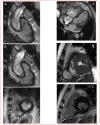Arrhythmias and Conduction Disturbances in Autoimmune Rheumatic Disorders
- PMID: 33936739
- PMCID: PMC8076972
- DOI: 10.15420/aer.2020.43
Arrhythmias and Conduction Disturbances in Autoimmune Rheumatic Disorders
Abstract
Rhythm and conduction disturbances and sudden cardiac death are important manifestations of cardiac involvement in autoimmune rheumatic diseases (ARD), which have a serious impact on morbidity and mortality. While the underlying arrhythmogenic mechanisms are multifactorial, myocardial fibrosis plays a pivotal role. It accounts for a substantial portion of cardiac mortality and may manifest as atrial and ventricular arrhythmias, conduction system abnormalities, biventricular cardiac failure or sudden death. In patients with ARD, myocardial fibrosis is considered to be the hallmark of cardiac involvement as a result of inflammatory process or to coronary artery occlusive disease. Myocardial fibrosis constitutes the pathological substrates for reentrant circuits. The presence of supraventricular extra systoles, tachyarrhythmias, ventricular activity and conduction disturbances are not uncommon in patients with ARDs, more often in systemic lupus erythematosus, systemic sclerosis, rheumatoid arthritis, inflammatory muscle disorders and anti-neutrophil cytoplasm antibody-associated vasculitis. In this review, the type, the relative prevalence and the underlying mechanisms of rhythm and conduction disturbances in the emerging field of cardiorheumatology are provided.
Keywords: Autoimmune systemic disorders; arrhythmias; conduction disturbances; heart involvement.
Copyright © 2021, Radcliffe Cardiology.
Conflict of interest statement
Disclosure: The authors have no conflicts of interest to declare.
Figures





References
Publication types
LinkOut - more resources
Full Text Sources

